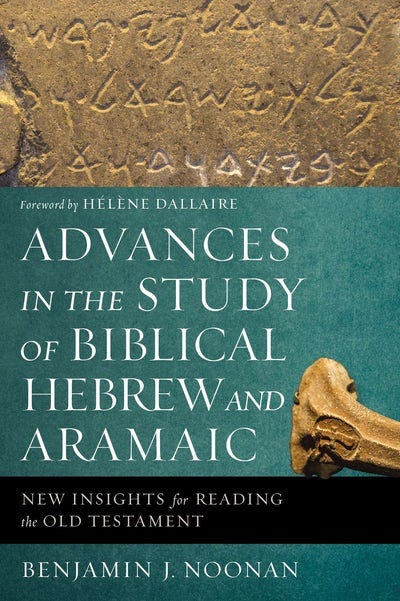Advances in the Study of Biblical Hebrew and Aramaic
Review by Jill Firth
Benjamin J. Noonan
Advances in the Study of Biblical Hebrew and Aramaic: New Insights for Reading the Old Testament.
Grand Rapids: Zondervan Academic, 2020.
Review by Dr. Jill Firth
This long-awaited book has fulfilled its promise. Students of Hebrew puzzled by scholarly discussions of linguistics, tense-aspect-mood, discourse analysis, dating of texts, and new methods for teaching biblical languages can also learn about lexicography, understanding the verbal stems, word order, register, dialect, style-shifting and code-switching. Noonan sets out each chapter with definitions, summaries of various views, and issues for consideration in evaluating different options. He proposes ways forward and suggests further reading.
Chapter 2 situates the issues in the history of Biblical Hebrew and Aramaic studies, beginning with medieval scholars such as Saadiah ben Joseph Gaon and David Kimḥi, then early modern scholars such as Johann Reuchlin. The influence of nineteenth and twentieth century Hebraists is noted, including Wilhelm Gesenius, Paul Joüon, William Foxwell Allbright, Godfrey Rolles Driver, and Naphtali Herz Tur-Sinai. Later chapters helpfully describe historical developments for each topic.
Many students will find the chapter on Tense, Aspect, and Mood (Chapter 5) informative. Noonan examines tense, aspect, and mood in turn, before discussing prominence. A brief history shows that tense was prominent for medieval Jewish grammarians and earlier Christian grammarians, who considered qatal as past tense and yiqtol as future tense, and wayyiqtol and weqatal as converted forms. Aspect prominence was proposed by nineteenth century grammarians Heinrich Ewald and S. R. Driver, who favoured the lens of perfect and imperfect, and considered wayyiqtol and weqatal as consecutive forms. Twentieth century comparative studies of Akkadian and Ugaritic led to further reflection. Further sections consider scholarship from 1980s onward, with evaluation of each approach, then a segment discusses Biblical Aramaic. Noonan follows John A. Cook in proposing some ways forward including the use of current linguistic definitions, situating theories within broader linguistics, attention to comparative Semitics, and diachronic shifts within Hebrew and Aramaic.
Discourse analysis (Chapter 6) is another discipline that includes a variety of approaches and terms. Noonan firstly presents a linguistic framework for discourse analysis before surveying some influential approaches. Discourse analysis is a newer field in biblical linguistics, which began around the mid-twentieth century. The chapter describes macrostructural and microstructural approaches including tagmemic, distributional, information structure, and inter-clausal, before describing and evaluating some grammars, commentaries, and other resources which use a discourse approach.
Chapter 10 discusses the question of Teaching and Learning the Languages of the Hebrew Bible in three sections: developments within the traditional teaching approach, the use of the newer communicative language methods, and strategies for retaining the use of the biblical languages. Many textbooks now include workbooks with exercises, and authentic biblical texts, and employ more innovative approaches to vocabulary learning, including online programs. Communicative language approaches have proved increasingly popular, and many teachers incorporate more listening, speaking, reading, and writing elements in their classes. Various print and electronic programs are easily available to prevent the loss of hard-earned biblical languages.
According to the endorsers, Advances in the Study of Biblical Hebrew and Aramaic “succeeds admirably” (Bill T. Arnold); and is described as “an indispensable resource” (H. H. Hardy II), and “an outstanding resource” (Elizabeth Robar). In addition, it is “up-to-date” (Robert B. Chisolm, Jr), “helpful and succinct” (John A. Cook), “easy to grasp” (Peter J. Gentry), and “accessible” (Miles V. van Pelt). The Foreword by Hélène Dallaire calls it a “masterpiece” including “the latest and best scholarship on the study of Biblical Hebrew and Aramaic.”
I read this book with great interest and enjoyment. It provides helpful background and analysis, as well as suggestions for further reading. Many lecturers, scholars, and students would benefit from this extremely helpful and readable book.
Dr. Jill Firth is Lecturer in Hebrew and Old Testament at Ridley College in Melbourne. She is co-editor with Denise Cooper-Clarke of Grounded in the Body, in Time and Place, in Scripture: Papers by Australian Women Scholars in the Evangelical Tradition.


